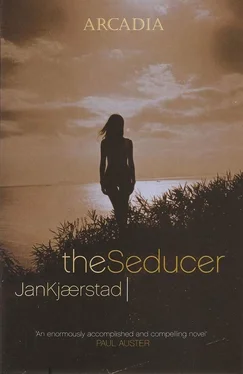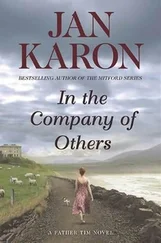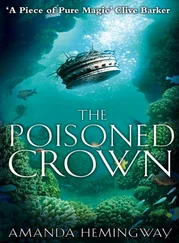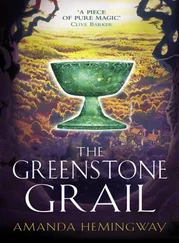Only later did Jonas realize that this was what had inspired his aunt’s endeavour to capture the entire world in a piece of jewellery, a piece which would only become a reality if she could find the one detail in the world that embodied the world. ‘There’s a legend,’ Jonas’s aunt told him on one occasion, her bracelets jingling, ‘that tells of a flower so perfect and so beautiful that if anyone were to find it and pick it, the world would disappear.’
It was at such times, lying on his back among silken cushions with his eyes resting on the rugs while his aunt sat working, surrounded by her graving tools, round burs and chasing punches, that Jonas used to beg her to tell him the tale of Princess Li Lai’s lovers. At such times the word ‘no’ never passed Aunt Laura’s lips, even though some people would no doubt consider this tale unsuitable for children. ‘In Xanadu,’ she said, ‘Princess Li Lai received another suitor in her cool palace, for she had yet to find one who could make love to her as she desired, one who would make love to her until she saw a turtle with a shell that looked like a face. On this day, the one who had come to woo her was the calligrapher Lu Xan, and he did not waste any time but carried her to the bed and immediately proceeded to make love to her. Right from the start, Lu Xan concentrated on the layers of lips enfolding her sex as if they were fine paper on which he was resolved to write. The princess felt his delicate member moving in strange, swift flicks across her lips, lines in a rhythmic dance, first from side to side then up and down then in arcs from left to right, stroke after stroke, patiently and at length, and as he made love to her more and more urgently, now sweeping his penis from the outskirts of her sex towards the centre, Princess Li Lai felt a warm glow begin to spread through her body as if she had moved out into the sunshine and were walking through a landscape which Lu Xan the calligrapher was slowly inscribing in her path, with bamboo groves and fold upon fold of mountains, seeming to go on forever. And as Lu Xan executed a few swift studied strokes with his member, the princess came to a river which suddenly overflowed its banks and swept her away, and she floated off, floated and floated in a warm stream that flowed faster and faster, swelled up and caressed her body, more and more powerfully, until she was thrown onto the bank where a troop of hares ran off in fright and soon all she could hear was the sound of their galloping paws, like heartbeats, and she opened her eyes and she saw a hare with the features of a human face that gradually changed into that of Lu Xan the calligrapher, the lover now lying looking down at her, and she thanked him, but asked him to leave, because she had not yet seen a turtle with a shell that resembled a face, and Princess Li Lai was sure that there must be a better way to be made love to.’
After a tale such as that, Jonas would lie on the sofa for a long time without saying a word. Complete silence reigned in the room, apart from the scratching or tapping sounds from his aunt’s workbench, which had also accompanied the story. When his aunt switched off the lamp, and Jonas looked round, he caught the glow of gold in the corner: soft but intense, magnetic, as if all of the remaining light were being drawn to that fragment of metal and, indeed, as if that one point could soak up everything, the whole world.
‘Tell me about Samarkand,’ he would say just before he left. It had become a ritual. He knew his aunt had been to Samarkand, and he asked the same thing every time.
‘As for Samarkand and what I found there, that I can never tell you,’ said Aunt Laura. ‘You will have to go there yourself.’
Jonas Wergeland is writing a’s in his copybook. He knows that he is involved in a solemn undertaking; he knows intuitively that this is a privilege, this fact of being able to sit here writing a’s. He had covered his copybook himself with the most fabulous waxed paper, carefully selected from the host of rolls in the stationer’s, in the most uncommon pattern possible. On the front is a label bearing his name, a label like the ones his mother stuck on the jam jars, as if to show that this book, this memory, has to be stored away, preserved in his recollection. Jonas dips his pen in the inkwell, a cheap plastic pen: black at the end where he fixed the nib and with a pale-blue shaft. Jonas writes another row of a’s, relishing the pressure of nib on paper, watches the wet ink slowly soaking into the fibres and drying, the tiny particles on the white surface bringing it home to him that writing is something concrete and palpable, a bit like his aunt engraving silver, he writes as neatly as he can — a a a a a a a — like a sigh of delight, something ecstatic, then draws a border. Borders are tricky, but there has to be a border. Jonas realizes that borders are important; they are ornamentation, they are a sign that the letters are not only letters but also something more, something beautiful: decoration or symbols harbouring a significance that extends far beyond the sound of ‘a’ or the word in which the letter appears. Jonas writes a’s, small characters that are like windows, openings onto other rooms, possibilities he has never seen before. The teacher comes over, she draws a lovely flower — Jonas has never seen such a lovely flower — in the bottom corner. Although his a’s are far from perfect and the borders are a bit crooked, she draws a make-believe flower as if to show that this — these a’s and borders — are as furrows ploughed in fertile soil in which almost anything can be made to grow.
Jonas Wergeland had not always been so sceptical of school. High school was one thing, elementary school was quite another. Where high school had represented a closing off, elementary school constituted an opening up. To the boy Jonas, those first years at elementary school were as exciting as the rugs in Aunt Laura’s flat, which is just about the greatest compliment a school could be paid: they were doors leading to wonderful rooms.
In Jonas Wergeland’s life there were only two sorts of school: the good and the indifferent. Elementary school was good, while junior high, high school and university were all indifferent. One could go so far as to say that Jonas Wergeland only ever had an elementary-school education, since this was the only public institution to teach him anything — the rest of his education he took care of himself.
Bearing in mind the fashion these days in literary circles for depicting the first years at school as a child’s worst nightmare, with teachers outdoing one another in acts of calculated terrorism, and pupils lying awake at night twisting their eiderdown covers into knots and muttering the most unlikely things to themselves, usually in Latin, I would like to present another, slightly different picture, not least because, from where I stand, it seems a mite strange, excuse me for saying so, that so many Norwegians — oddly enough, almost invariably people who have done very well for themselves — are forever whingeing about childhood and schooldays when one considers the less than idyllic conditions in schools in other parts of the world, where something as basic as a blank sheet of paper is like gold.
What I am saying is that when it comes to Jonas Wergeland’s elementary school, to Grorud School, you have to dispense with all the horror stories found in books and newspapers. Grorud School was no different from other state elementary schools of that time. It looked exactly as a school should: a great mastodon of a brick building with such standard features as drinking fountains with holes that you could press your finger over and send jets of water shooting sky-high, not to mention right in the face of some poor first-grader; a shed behind which to sneak a quick puff and lavatories in the basement where the girls could share their acquired knowledge in secret, and the boys, just as secretly, could spurt out their semen after catching an unbearably arousing peek of the English teacher’s bra between two of her blouse buttons.
Читать дальше












